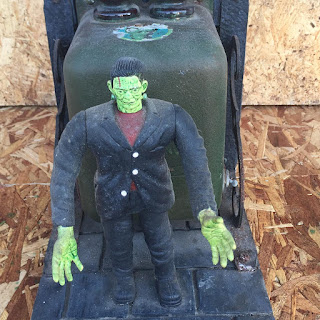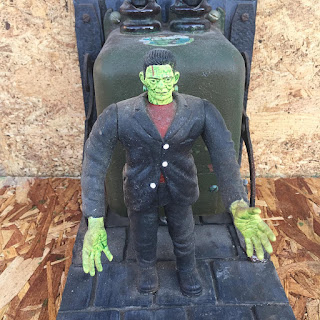At least in 1818. Two hundred years ago tomorrow, famed writer Mary Shelley wrote her monstrously famous story.
A Literary Volcano
It was a dark and stormy summer, 1816, rather the year without summer. Fourteen months earlier in the Dutch East Indies, Mount Tamboro blew nearly a mile off its top, 1450 metres, the most powerful volcanic explosion in recorded history.
Twelve thousand people were killed immediately. Another 60 000 to 80 000 subsequently died of starvation.
Volcanic ash erupted high into the atmosphere blanketing the skies. Southeast Asia was plunged into the blackness of night for over a week.
More than a year later in the eerie half light of the Northern Hemisphere, birds nested at noon. The Americas and Europe experienced massive agriculture failures. Zealots predicted the End Times were nigh. Switzerland was not immune.
“Never was a scene more awfully desolate. The trees in these regions are incredibly large, and stand in scattered clumps over the white wilderness; the vast expanse of snow was chequered only by these gigantic pines, and the poles that marked our road: no river or rock-encircled lawn relieved the eye by adding the picturesque to the sublime,”recorded 18-year-old Mary Wollstonecraft Godwin.
Mary Shelley, author of Frankenstein; or, The Modern Prometheus.
A Charming House of Horror
In that non-summer of 1816, Percy Shelley rented a house near Lake Geneva for himself, his fiancée Mary, their toddler son ‘Wilmouse’ (William), and her six-month younger stepsister, Claire Clairmont, sometime lover of (and pregnant by) Lord Byron (yes, THAT Lord Byron) who happened to rent a nearby villa. His entourage included his physician, Dr John Polidori, who played a part in events that unfolded.
That dark and dreary summer turned out to be a platinum mine of ideas as these innovative geniuses sat around drinking and talking philosophy, politics, and poetry. As candles flickered and lightning slashed the sky, Lord Byron seized upon the frightening atmosphere. He proposed they each write a ghost story.
Early in the wee hours, Mary awoke from a nightmare. She’d dreamt of a mad scientist who sparked new life into a hideous figure. Within a day, certainly within a week, she began jotting initial notes of a story that would become world famous.
Lord Byron, while failing to meet his own challenge of a ghost story, nevertheless wrote his famous poem, Darkness. Meanwhile, Dr Polidori began writing a supernatural story of his own that would also become well known.
Under a Frankenstein Moon
A small but intriguing mystery surrounded the dates of Byron’s challenge and when the writers actually set to work. Researchers became interested partly because of the prominent writers and poets involved, but also as a sort of test of the veracity of Mary Shelley’s writings: Could her claims of events be taken as factual, or was she prone to exaggeration or invention?
Academics from Texas State University, including literary specialists, astronomers, and a faculty physicist, descended upon Cologny, a canton of Geneva. From clues in the notes of Mary and her companions, scholars were able to verify Shelley’s notes and further pinned down dates of events detailed in the table below.
Frankie and Friends
Fans of early monster movies noticed considerable cross-pollination, particularly in Universal Studio properties circa 1931-1954. Time and again, Frankenstein would appear in a Dracula film or vice versa, often with friends like the Invisible Man, the Wolf Man and the Mummy (respectively starring Boris Karloff, Bela Lugosi, Vincent Price, and Lon Chaney Jr in the latter two rôles. These characters also appeared in Abbot and Costello Meet Frankenstein.
Universal didn’t innovate the mixing and matching of monsters. I mention the Dracula character because that night in 1816 planted the germ of what would become the first modern, romantic vampire tale. Inspired by Lord Byron’s challenge, John Polidori began writing The Vampyre, eventually published in 1819.
Here an unpleasant twist took place. Polidori showed the manuscript to Ekaterina, Countess of Breuss. Without the knowledge of Polidori, the countess, or more likely her friend, a Madame Gatelier, turned the story over to Colburn’s New Monthly Magazine, where it was serialized starting in April 1819 under Byron’s name: The Vampyre: A Tale by Lord Byron. Thereafter, it was published in book form, again failing to credit Polidori. Both men protested. By the second edition, Polidori’s name finally appeared as the author, but not before his premature death. Debt-ridden and depressed, Polidori had swallowed cyanide.
Three-quarters of a century later, Polidori’s story would influence an Irish writer, Bram Stoker. His renown novel, Dracula, appeared nearly eight decades after Polidori’s Vampyre.
Time Line and Context
Notable 19th Century English Authors
- 1811 October 30
- Jane Austen publishes Sense and Sensibility.
- 1813 January 28
- Jane Austen publishes Pride and Prejudice.
- 1815 April 05-15
- Mount Tambora in Indonesia erupts, most powerful volcano in written history, darkening skies nearly two years.
- 1816 June 15-16
- Lord Byron challenges guests to write ghost stories.
- 1816 June 16-17
- Byron’s physician, John Polidori, begins writing Vampyre.
- 1816 June 16
- Mary Shelley experiences nightmare of scientist who breathes life into a terrifying figure.
- 1816 June 17
- Mary Shelley begins outlining idea that would become Frankenstein.
- 1816 July 15
- Lord Byron, influenced by the eerie summer’s half light, writes his apocalyptic poem Darkness.
- 1817 December 30
- Mary Godwin marries Percy Shelley.
- 1818 January 01
- Frankenstein is published by the firm of Lackington, Hughes, Harding, Mavor & Jones.
- 1819 April 01
- John Polidori’s story, the first modern vampire tale, The Vampyre, is published without Polidori’s knowledge or permission.
- 1821 August 24
- Dr John Polidori dies without his authorship fully resolved.
- 1836-1870
- Charles Dickens’ body of works spans 35 years.
- 1847 October 16
- Charlotte Brontë publishes Jane Eyre.
- 1887 November 21
- Arthur Conan Doyle sees publication of first Sherlock Holmes story, A Study in Scarlet.
- 1897 May 26
- Bram Stoker publishes Dracula.





